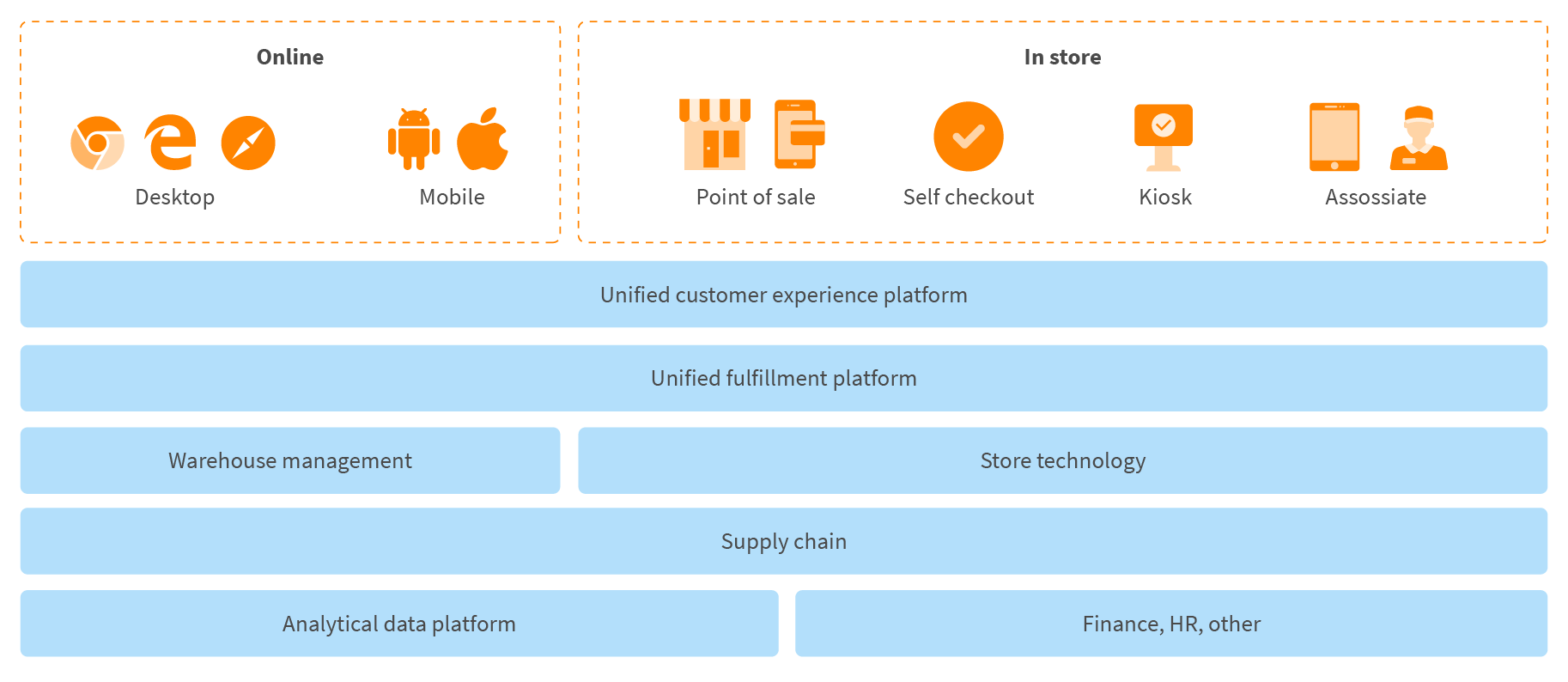
Unified commerce: Making the most of a true omnichannel experience
Initially, digital transformation for brick-and-mortar retailers meant creating a good customer experience over web and mobile channels. While that started to close the retail chasm that Amazon had opened beneath traditional retailers, it wasn’t as if they could abandon their stores and go all-digital.
Nor should they. Those stores are a competitive advantage over Amazon and retail’s other digital natives. And that’s where unified commerce -- a true omnichannel shopping experience -- comes in.
Business drivers behind developing a unified commerce experience
Combining online and brick-and-mortar shopping into a fully omnichannel experience can create competitive advantages over what digital native retailers can offer -- if it’s done right. With customer experience playing an increasingly vital role as a brand differentiator, seamless consistency between channels is key. But unified commerce’s real art is found in leveraging each specific channel for its unique benefits.
At the same time, the retailer can benefit from the vastly expanded library of data about everything from conversion rates to loyalty incentives. In-store experiences can inform merchandising online while online patterns can help individualize each customer’s in-store incentives.

Mixing channels
Combining channels during a single shopping experience lets customers interact with products as they see fit.
- Buy online and pick up in-store: Customers get to see exactly what they’re buying, while retailers get to help them encounter even more things that they may want to buy. This also works for buy online and return to the store -- perhaps they’d like to exchange for something else?
- Buy online and ship from the store: Retailers can optimize their inventory by using stores in addition to warehouses and distribution centers. Two added bonuses: Local shipments are cheaper and customers get products faster.
- Shop in-store before buying online: Customer didn’t find the desired color or size? Because unified commerce gives retailers a full view of their entire inventory at any given time, it’s easy to increase overall conversion rates with free shipping.
- Omnicarts: Customers can fill their unified shopping cart online and then interact with products in the store, helping sales teams in both channels optimize recommendations, offers, and marketing campaigns.
Keeping an eye on the big picture
With unified commerce, merchandising and marketing teams get a single pane of glass to centrally manage pricing, promotions and offers, push changes to both the website and stores in minutes, and provide seamless experiences for customers.
- Unified commerce provides a 360-degree view across each customer’s online and in-store activities, creating unique opportunities that don’t exist exclusively in a single channel.
- Unified loyalty programs: Customers can use offers and coupons seamlessly whether they’re shopping online or in the store, while coupon tracking can enhance loss prevention by preventing repeated use of a one-time offer.
- Personalized merchandising: Because sales associates can see what VIP customers have been looking at online, they can make in-store suggestions and track what was of interest in the dressing room. When the customers go back online, favored items populate their home screen.
Enhanced analytics
Creating a true omnichannel unified commerce experience also means digitally augmenting stores with advanced analytics capabilities and putting a wealth of customer information at each sales associate’s fingertips. Such augmentation can include providing easy access to the brand’s global catalog and its entire inventory, while also pushing detailed pricing and promotions information out to increase in-store conversion rates.
Allowing the merchandising team to manage both in-store and online pricing, offers and promotions from a centralized management UI creates new opportunities for single-store or regional specials to meet local needs. Flexible pricing and offers also helps with loss prevention, preventing associates from abusing custom manual discounts.
Unified commerce also means a whole new library of product data. Retailer TechStyle Fashion Group has found that every aspect of their business can leverage that wealth of new data. For example, one particular style of yoga pants had been selling well, with an in-store conversion rate around 25 percent. But a single size -- XXS -- only converted at 19 percent. Initially, that was puzzling, because online return rates were consistent across all sizes. But the product’s designer discovered a problem with fit in the legs of the XXS; as soon as the problem was fixed, that size began selling as well as all the others.
Obstacles to building out the unified commerce experience
The clarion call to create a unified commerce experience is abundantly clear. But that doesn’t mean it’s going to be easy -- particularly not if your business already is built on monolithic third-party platforms.
As good as monoliths like ATG may have been back when digital transformation first began, they have become isolated silos blocking the transition to unified commerce. And it hasn’t been just your e-commerce platform getting in the way; that point-of-sale platform also has become a legacy problem.
Each platform comes with a set of features that are duplicated by other monoliths, including such things as catalog, search, pricing, inventory and promotions.

Not only do you end up paying twice to buy the same functionality -- once for your online platform and once for your in-store/POS platform -- you also have significant additional costs to orchestrate and integrate between the two systems. You get two copies of your business logic functions, too, which makes it hard to build a consistent customer and merchandising experience.
And yet your customers still don’t get a unified commerce experience.
Data is spread between the various systems, making it far more difficult to collect it in one place -- much less use it in a unified manner.
In the end, you still need to invest in integration and build or buy yet another system -- a third system -- to manage data and provide authoring and management UIs for your merchandising and marketing teams.
In truth, you end up paying three times for the same functionality without achieving a consistent experience. Not only that, the laborious process of pushing changes out one by one to three platforms means you’ll have to wait longer for each new feature to implement across the board.
On top of all of these technology issues, there are institutional problems to contend with. Internal organizational structures set up long before unified commerce was a glimmer in anyone’s eye can come back to haunt the digital transformation process. For example, in some companies the chief technology officer may not be responsible for the point-of-sale system, making it difficult to loop that system into any integration effort.
Outdated organizational decisions also can mean that incentives need to be modernized. If an in-store agent gets credit for an online sale, they’re far more likely to suggest the online transition to a customer. Similarly, merchandising teams with responsibilities split between in-store and online may have no incentive to improve sales outside of their singular mandate.

Microservices to the rescue
Fortunately, there’s a way to reach your unified commerce goals without having to rip and replace legacy systems. Instead, you can deploy headless e-commerce and microservices alongside any existing monolithic system and still take advantage of their speed, flexibility, and scalability. Full migration can take place seamlessly over time -- sometimes referred to as “strangling the monolith” -- through the gradual replacement of components with microservices.
These small, freestanding applications -- each built around a single business purpose -- can be woven together under one unified UI, allowing them to work seamlessly on every platform in a unified, coherent way.
Because each has its own data store and well-defined APIs that allow them to extend to any new touchpoint, microservices can be deployed independently. The business can use only what it wants as it’s needed, without having to shoehorn new code into an existing legacy system.
Decoupled from other components of the commerce system, microservices can be updated rapidly without compromising other services and without requiring the kind of full-system testing legacy platforms require.
With headless e-commerce, data moves seamlessly through the entire organization, allowing innovation and experimentation in a matter of days or weeks instead of the laborious months-long customization processes required for monolithic systems.
Each microservice transparently underlies both online -- web and mobile -- and in-store channels. Whether it’s a web user interface, a mobile app, a point-of-sale service, an in-store commerce app, a kiosk, or a self-checkout service, each microservice offers a thin user interface to the integrated data and services inside the overall architecture.
One of the questions that remains, however, is whether to deploy services in the store or simply connect everything in-store to the cloud. Each retailer's answer to this question may be different and depends on whether a retailer can build highly reliable and low-latency connectivity from stores to the cloud. When reliable connectivity is not possible, a retailer may want to deploy partial services to the store to ensure that it can function even if the cloud connection is severed. Microservices can help build automated offline-to-online syncing to smooth any transitions between centralized data and what’s gathered in-store.
Fog or edge computing can help with this kind of in-store deployment. A retailer can standardize cloud and store infrastructure on technologies like containers and Kubernetes, allowing them to manage store and cloud infrastructure in a uniform way.
Implementing edge computing in stores helps to integrate more peripheral devices such as sensors and store cameras to improve the customer experience, enhance store operations, and gather more data for novel and potentially innovative analytics.
Conclusion
Ultimately, only retailers offering both an in-store and online experience can offer everything a customer wants and needs. That’s a powerful advantage over your digital-native competition. To reap the greatest rewards, unified commerce requires taking full ownership of the entire technology array. The right architecture patterns can take full advantage of microservices, the cloud, edge and fog computing, and containers to implement a true omnichannel experience.
Unifying under a headless commerce banner
We can help you weave together your unified commerce experience with microservices that pull the best-of-breed tools from cloud, edge, and fog computing into one seamless platform. An experienced engineering services company like Grid Dynamics knows how to orchestrate the process while avoiding the potential pitfalls.
Contact Grid Dynamics to optimize your digital transformation into a unified commerce powerhouse.
